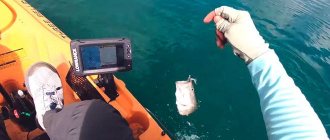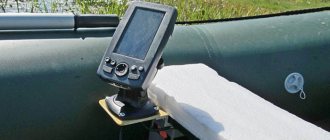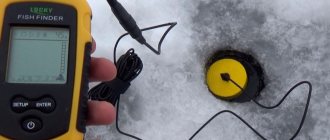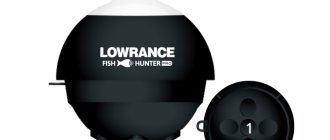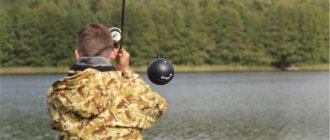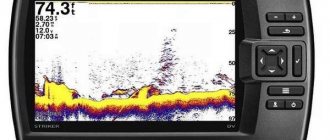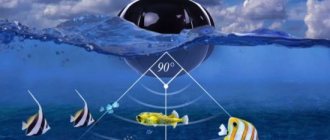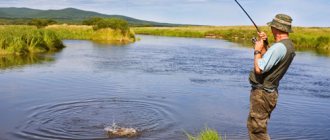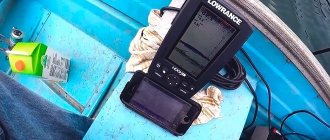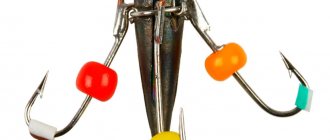Both beginners and avid fishermen have heard more than once about a wonderful technique that can help find large fish in any body of water. But few outdoor enthusiasts believe in modern technology, preferring to fish using the old method, focusing only on luck.
The focus of this article is a unique device that can really help fishermen, its name is an echo sounder. This device is guaranteed to help fishermen make their time on any body of water productive. The reader is given the opportunity to learn detailed information about this device: principle of operation, areas of application, as well as get acquainted with interesting models presented on the domestic market.
A miracle device in the service of fishermen
It’s better to start with the tactical and technical properties of the device itself. An echo sounder is a measuring device. What? In this case we are talking about the distance from the surface of the reservoir to its bottom. This is a regular sonar that can “see” under water and show the result to the user.
What will this give the fisherman? First of all, the user receives the topography of the bottom of the reservoir. Moreover, the echo sounder is capable of not only clearly showing all the depressions and irregularities, but also specifying the type of soil (stone, sand, silt, clay). Secondly, the device is capable of identifying objects directly in the water. It doesn't matter whether they move or not. It is this property of the device that allows the fisherman to determine whether there is a fish nearby and what its approximate size is.
Operating frequency of the echo sounder
The operating frequency of the echo sounder is one of the most important technical characteristics, since the following capabilities of the device depend on it:
- The depth at which underwater objects are detected.
- The degree of detail of detected objects with a constant power indicator.
Previously, echo sounders could only use low or high frequencies, depending on the characteristics of a particular model; all modern models have the ability to simultaneously or selectively use both types of frequencies.
Operation at different frequencies has the following features:
- When working with high frequencies, the width of the diagrams changes , and the cone begins to narrow. This significantly increases the density of sound energy, which gives the user the ability to detect even small objects located at great depths.
- When switching to a low frequency, a proportional expansion of the cone is observed , which reduces the density of sound energy in it. There is a loss of the ability to study great depths or search for small objects, but at the same time, fish are detected in a wider area.
Influence of the propagation medium of sound waves
Ultrasonic waves created by the transducer propagate in an aqueous environment, which has a significant impact on the quality of the device as a whole.
First of all, it depends on the following environmental characteristics:
- Attenuation of ultrasonic wave energy in an aqueous environment.
- The presence of reflection of ultrasonic waves in one medium, which allows you to create an echo signal.
Energy decay
The attenuation of the energy of sound waves is due to the presence in the aquatic environment of a large number of various organic and mineral compounds, air bubbles and microorganisms. All of them partially absorb the signals distributed by the echo sounder.
In total, there are two types of energy attenuation:
- Free space attenuation is a natural process that depends not on the specifics of the environment, but on the signal range.
- Attenuation of energy due to repeated passage of the same distance, which occurs during active sonar.
The degree of energy attenuation also depends on some features of the medium; the main principles are as follows:
- In fresh water at low temperatures, energy decay occurs much more slowly, since such a medium is characterized by increased density and lower concentrations of various organics.
- In sea water, energy decay occurs faster due to the high concentration of salts. This process is accelerated when passing through the upper water layers, which are usually heated better and have a higher temperature.
Presence of reflections
Reflections are formed if a sound wave encounters any object whose density differs from the environment, which can be:
- Fish or other underwater inhabitants.
- Bottom surface.
- Stones.
- Underwater vegetation.
- Large air bubbles.
- Separate layers of water with a different temperature, they are called thermoclines and are found in large bodies of water.
Reflective properties of the bottom
The bottom surface of many large reservoirs has a heterogeneous structure; reflective properties depend on its specificity:
- Stones , other hard objects and clay surfaces are highly reflective, which creates fairly wide lines on the device screen.
- Underwater vegetation , muddy or sandy surfaces are weakly reflective, so they create thin lines on the screen.
Sand, silt and other soft surfaces allow ultrasonic waves to pass through them well, so they can provide images of harder masses located underneath them.
Types of echo sounders
It is logical to assume that such an interesting device can only be used while directly on the water surface of a reservoir. However, this is a misconception, and it all depends on what modification of the echo sounder the user has. We figured out what kind of device this is, it’s time to find out more interesting details.
Stationary echo sounders are considered the most popular in the world. They are installed on the dashboards of boats, fishing schooners, and are also used on other water transport not related to fishing. A special sensor (transducer) from the device is located on the bottom of the boat; its task is to scan the bottom.
Portable wired fish finders are a smaller version of stationary devices and are widely used by ordinary fishermen from boats and boats. Such devices have fewer sensors, and the mechanism itself is a little simpler.
Also on the market, the buyer can find portable wireless echo sounders. With such devices, bottom scanning can be carried out from the shore, throwing the transducer at a distance of 50-100 meters with a conventional spinning rod.
How does an echo sounder work - how it works, how to use it?
Before using the echo sounder, it is recommended that you become familiar with the basic principles and mechanisms on which its operation is based.
The design of all modern models consists of the following main parts:
- A display that displays text and graphic information.
- A transmitter that performs the functions of an emitter.
- Receiver of incoming signals.
- A converter on which the operating parameters, characteristics and capabilities of the equipment depend.
All named elements of the device, as well as their functions, tasks and other features, are discussed in more detail below in the relevant sections.
How the echo sounder works
Today there are a large number of different models and their modifications on sale, differing in performance characteristics and basic set of functions.
All such devices operate according to a single principle, which consists in performing the following algorithm of actions:
- After turning on the echo sounder and putting it into operating mode, the sensor begins to create and propagate high-frequency pulses at a given frequency. Most modern devices use frequencies of 50 kHz or 200 kHz; models with an adjacent value are less common.
- The pulses created by the sensor begin to spread throughout the reservoir, and they are reflected from all obstacles encountered: the bottom surface, fish, sunken objects.
- The echoes are returned and processed by the receiver, resulting in the creation of electrical impulses.
- The pulses generated by the receiver are transmitted to the converter, where they are amplified multiple times.
- The converted electrical impulses are sent to the display, where they are displayed in a form understandable to the user; these can be numerical values or graphic images.
- The echo sounder display functions not only to display information , but also to control the entire device; for this purpose, the device is equipped with a keyboard.
The following principles apply to displaying the space directly below the craft:
- Fast or vertical scan . All echo pulses received by the receiver appear on the screen in the form of black stripes or dots, which are spaced from the surface line at a certain interval: it is necessarily proportional to the depth where the reflective element was detected. This allows you to virtually instantly obtain a picture of what is happening under the vessel at the current moment in time.
- Horizontal scan performs other tasks; with its help, the image on the screen moves to the left side, and also displays depth-time coordinates. Thanks to this, the user gets the opportunity to study the picture of what is happening under the boat in the past period of time.
In accordance with the described principles of operation, when the swimming craft is stationary, the bottom surface looks like horizontal stripes, and the fish from which the impulses were reflected move on the screen to the left along with the horizontal scan.
When you start moving, you can observe a change in the bottom display if the current depth changes. Most modern models allow you to manually adjust the sweep speed and synchronize it with the speed of the vessel, which ensures complete clarity of the picture.
Where does quality start?
Since an echo sounder is a device for measuring, and not for displaying an image, first of all, all potential buyers need to know that they are purchasing a scanner, and not an LCD TV. Accordingly, the quality requirements must be appropriate.
The most important criteria in the device are the number of beams and their scanning angle. The higher this indicator, the more efficiently and quickly the device receives information. For example, 6-beam echo sounders allow you to scan the bottom while a boat passes through the water surface on a glider (60 km per hour or more). Single- and double-beam devices are popular.
The second criterion is security. The echo sounder will be used close to water and at different times of the year, so its performance directly depends on the protection of the housing (water, shock, cold, heat). Naturally, this parameter also affects the cost of the device and in no case should it be neglected.
Echo sounder sensitivity
The sensitivity of an echo sounder is usually understood as characteristics that give it the following capabilities:
- Differentiation of weak echoes from receiver noise and other acoustic interference.
- The ability to search for small objects at considerable depth and display them on the screen.
High sensitivity allows you to obtain more information about the underwater space, but when operating at shallow depths, the device begins to receive signals located outside the main beam.
For ease of use, it is possible to change sensitivity indicators depending on environmental conditions:
- Manual sensitivity correction was required when operating older models of echo sounders.
- Automatic determination of optimal sensitivity indicators occurs in most modern models.
When it comes to convenience
But the size of the screen and its type can be paid attention only after the buyer has decided on the basic characteristics. As practice shows, users give preference to the size of the display rather than its color. After all, in fact, the beauty of the fish or the bottom of the reservoir is not what the fisherman needs - he needs the relief and the presence of living creatures. In addition, a device with a color display consumes more electricity.
True, many potential buyers think this way, until fate presents them with a Lowrance Elite-3x echo sounder. A device costing 10,000 rubles on the domestic market quickly forces many fishermen to make a purchasing decision. The fact is that this budget representative is not only equipped with a color liquid crystal display and has excellent protection against shocks and splashes, but is also able to quickly scan the bottom of the reservoir. After all, its transducer has two sensors that operate in different frequency ranges (83 and 200 kHz).
How to avoid mistakes when using an echo sounder?
All the main mistakes when operating echo sounders are associated with a misunderstanding about the principles of their operation and display of information.
In order to avoid various mistakes, it is necessary to take into account the following nuances:
- The device does not display a local section of the reservoir under the ship , but a much larger part of it, since the radiation propagates in different directions. But on the display the display occurs only in one plane.
- Echo sounders do not display spatial images of fish in relation to the watercraft. The projection is carried out on a vertical plane passing through the central axis of the cone.
- Between the opposite boundaries in the ray field there may be a foreign object that is part of the bottom surface. This will be marked as a shaded area on the screen and fish in this area will not be detected. However, it can be seen with a narrow beam that does not capture the interfering object.
Higher, faster, stronger
Yes, any owner wants his sonar to be able to work with navigation maps and have a GPS system in addition. All this is quite realistic, only the cost of such devices will be appropriate (prices start from 30 thousand rubles). When choosing your first echo sounder, the main thing is to stop in time and make a decision for yourself about what is really a priority.
Often, many avid fishermen agree that any equipment is directly proportional to the application. For example, the Lowrance Elite-3x echo sounder (83-200 2 beams) has positive reviews only from owners of motor boats and boats with electronic ignition. Yes, although the device is portable, it has problems with power supply (the device will work for no more than 24 hours on a single charge). But what about the rest - carry a bag of batteries with a supply for a week?
How the echo sounder works
From the name of the device itself, it becomes clear how it works: “echo” means a reflected signal, and “lot” means a depth meter. If you combine these concepts together, you get a device that measures depth using a reflected signal.
An echo sounder for fishing from the shore consists of an indication device and a sensor. This is often a wireless sensor. To determine whether there is a fish at the fishing point, you need to attach the sensor to the fishing line and throw it to the biting point. When the sensor gets into water, it begins to work immediately, since the contacts close when it comes into contact with water.
After the sensor is turned on, it transmits all information via a radio channel
Developments that use a tablet or smartphone as an indicator may attract attention
The sensor slowly moves towards the shore and scans the bottom, as well as the water column below it. The fisherman watches everything on the screen of the receiving device, which reflects the bottom topography, as well as all objects that fall within the sensor’s visibility range. If the place is baited, then the sensor can be placed above this place and observe how the fish reacts to the bait.
TOTAL DRAIN OF ECHO SOUNDERS Deeper, PRACTITIONER, Ibobber Personal experience at the request of viewers SIBERIA
Watch this video on YouTube
Simple and practical solution
Since an echo sounder is a device for scanning the bottom, it is better for a potential buyer to start getting acquainted with simple models that are oriented for this task. The domestic device “Praktik ER-6 Pro” is the golden mean in this segment. After all, it is able to satisfy the buyer with an affordable price (5000 rubles) and excellent functionality.
An inexpensive echo sounder can scan the bottom and provide the user with detailed information on the screen. The device is also capable of finding fish in the water and notifying the user about it. As for the protection of the body, judging by the reviews of the owners, there cannot be a single question at all. The echo sounder works great in any weather conditions (from 50-degree heat to 20-degree frost).
Rating of the best echo sounder models in Russia
Fifth position – Rivotek Fisher 30
The presented device is portable. It has a monochrome display with a diagonal of 2.4 inches. The echo sounder is intended for use exclusively in the warm season. Main characteristics:
- Operating temperature (maximum): 70°;
- Number of rays: 1;
- Beam angle (total): 90°;
- Converter frequency: 4333 kHz.
Fishermen shared their impressions of the operation of this echo sounder:
“Quality model. I bought it specifically for summer fishing and was pleased with it. The device works exactly like a clock. Can be used when fishing from a boat or from the shore.”
“Reliable and high-quality echo sounder. I cast it about 50 meters, and it did its job perfectly, showing fish, thickets and relief on the screen. I was especially pleased with the light weight of the device and its convenient shape, because you can hold it in your hands for a long time without getting tired, or hang it around your neck.”
Quad position - JJ-Connect Fisherman 220 Duo Ice Edition MARK II
A portable echo sounder model with a waterproof housing. Its main advantages are its convenient size and high accuracy when studying the terrain. The device is 2-beam and operates at a depth of up to 73 meters, so it is suitable for fishermen who usually go for catch in not the deepest bodies of water.
Its power source is 4 AA batteries. The developers also equipped the device with a temperature sensor. As for the disadvantages, the presented model does not detect small fish well and is not accurate enough when working in winter. Reviews about it are as follows:
“A good echo sounder for fishing in the summer. The only thing I don’t like is the identification of small fish in the form of dots. This is how I displayed 100 gram perch and 200 gram roach. It’s better not to use this model in winter.”
“I bought this echo sounder because it has 2 beams and a convenient shape. Everything is working. Particularly convenient is the high-contrast display, on which everything is clearly visible in any weather.”
Third position Lowrance Mark-5x Pro
It is a stationary model that can easily be attached to the transom of the boat. Distinctive characteristics:
- Display: monochrome with a resolution of 480x480 pixels and a diagonal of 5 inches;
- Number of rays: 2;
- Working depth (maximum): 305 meters;
- Power supply: from 12 V mains;
- Additional functions: presence of a temperature sensor.
See fisher reviews about this echo sounder below.
“I will highlight two main advantages - low energy consumption and a clear image. In addition, we are pleased with the presence of Russification and the fact that not only fish, but also other underwater objects are displayed on the screen.”
“For a while, this echo sounder didn’t work very well for me: it froze and calculated the wrong depth, but later the problem resolved itself. I don’t know what caused that failure, but now the device is working normally.”
Second position – Humminbird PiranhaMAX 175
This echo sounder differs from similar models in the presence of a stationary mount and power supply, although the latter, of course, is a disadvantage. The characteristics are as follows:
- Screen: high contrast, monochrome;
- Number of beams: 2 (games 16 and 28 degrees);
- Working depth (maximum): 183 meters.
Here's what the fishermen wrote about this device:
“At first, the menu and control buttons seemed inconvenient to me, but after that I got used to them. The echo sounder works well, but what irritates me is that the beams work separately and not together.”
“A high-quality and reliable device. I bought it based on its main characteristics, and I was not mistaken - the catches have increased significantly.”
Position No. 1 – Practitioner ER-6PRO
Echo sounder of domestic production. It is universal, because it is able to work at temperatures from -20 to 40 degrees. Its advantages include its small size, which makes it easy to carry, and powered by just one regular battery. If we talk about the characteristics, the scanning depth is 25 meters, and the number of beams is 1. In addition, the model has 5 operating modes and is very inexpensive. The only negative is that the keys are a bit stiff, causing some discomfort when pressed.
Feedback from fishermen can be found below:
“I am impressed after my first fishing with an echo sounder. The device is absolutely worth the money. It works very accurately, weighs little, and fits comfortably in the hand. In general, I am pleased with my purchase, I hope it will not disappoint me in the future.”
Thus, having familiarized yourself with the general technical characteristics of echo sounders and a review of the most popular models, taking into account the characteristics of your own fishing, you will be able to choose a device that will meet your requirements, rather than having to figure out what’s what right in the store.
Fishing from the shore
Wireless echo sounders are quite popular among fishermen who do not have surface vehicles and prefer to cast their rods from the shore. To tell the truth, this category of people tries not to trust electronic devices and relies on their own experience or the recommendations of other fishermen. As practice shows, broken gear and poor fishing without an electronic device are considered a common failure. But everything could be completely different.
Unlike a wired device, in wireless echo sounders the transducer communicates with the head unit via a radio channel, vaguely reminiscent of a Wi-Fi signal. Therefore, the main criterion for choosing a decent device on the market here is the power of the wireless transmitter and receiver with which the echo sounder is equipped. This is not the only important criterion. As with other devices, the device requires a high-quality scanner that can work at a wide angle.
Operating the echo sounder
The operating rules for different models of echo sounders may vary ; below we will discuss the basic rules and features characteristic of all modern devices.
Displayed information
The information displayed by the fish finder depends on the features and capabilities of the specific model.
Most modern devices provide users with the following information:
- The depth of the place over which the craft passes.
- Power supply voltage indicator.
- The temperature regime of the reservoir, if an appropriate sensor is installed.
- The speed of movement of a watercraft with a sensor.
- The fish is displayed as a special icon; some models have the ability to provide sound alerts.
- Thermoclines and the space beneath them.
- Relief and structure of the bottom surface.
Echo sounder control
Depending on the selected model, the echo sounder is controlled using the keyboard or the on-screen menu.
Typically the following buttons are present:
- A set of arrow buttons is required to select functions.
- The Enter button is required to enter the selected mode, confirm the selection of a function, or turn on the control panel.
- The Setup button allows you to enter or exit the settings menu.
- The Power button allows you to turn the echo sounder on and off, as well as connect the backlight.
Depth scale (Range)
The depth scale is required to perform the following functions:
- Manually setting the depth indicators of the area about which you need to obtain information.
- Automatic determination of the depth of the area where the vessel is located.
- View information about the area of interest.
Zoom
This function allows you to enlarge and study in more detail the selected area on the device screen, taking into account the specified depth.
Typically, the display is divided into parts with several windows:
- The first window is intended for viewing in standard mode.
- The second window displays the user-selected area taking into account the set scale.
Gain, sensitivity (Gain)
The article has already mentioned the influence of sensitivity indicators on the functioning of the echo sounder. In most modern models, this indicator is selected by the device automatically, but the possibility of manual adjustment by the user is retained.
To do this, through the settings menu, you need to go to the Gain section and adjust the sensitivity indicators yourself.
Image (Chart)
Changing image-related settings allows you to adjust scrolling, which will affect the speed at which information is updated on the device display.
To do this, in the Chart menu you will need to find the Scroll Speed function, for which you can set the following values:
- Fast – fast scrolling.
- Medium – scrolling at medium speed.
- Slow – slow scrolling.
Frequency
The Frequency function allows you to set one of the following modes of operation of the device:
- High frequency at 200 kHz is a mode that is enabled by default on most models.
- Low frequency mode : 50 kHz.
- Combined mode , which allows you to simultaneously use waves with low and high frequencies.
Fish Symbols
In the corresponding menu, you can adjust the display features of fish, which can be done in the following way:
- The Off value turns off the fish display mode, in which case they will be represented as stripes, like other reflected objects.
- The On value turns on the fish display mode; unlike other reflected objects, they will be indicated with a special icon.
- The ability to display fish with icons of different colors when the echo sounder is operating in dual-frequency mode. This allows you to understand whether they were irradiated with a narrow or wide beam.
Whiteline
This function allows you to display the surface of the bottom of a reservoir in different ways:
- When the mode is turned off, the bottom is displayed as a uniformly colored black area without detailed structure.
- When the mode is turned on, the bottom is painted in different shades, which reflects its structure and structure.
Tools
The Tools menu usually includes 4 sets of tools that you can use:
- Depth Line allows you to use the “depth line”, with which you can determine the depth to the underwater object of interest or select it.
- Flasher is a beam that allows you to create an image on a vertical strip, which contributes to increased detail of the water column and bottom structure.
- Noise Reject is a noise reduction tool, with its help the resulting image can be cleared of unwanted noise.
- Simulator is a tool for learning how to use an echo sounder and testing its basic functions.
Fish detection alarm (Alarm)
Many modern models of echo sounders are equipped with the ability to sound a sound signal when a fish is detected.
This feature has the following features:
- The alarm continues to work when FishSymbols mode is turned off.
- The alarm can be set to sound when fish of a certain size are detected.
Image on the echo sounder screen
In order not to experience disappointment from using an echo sounder in practice, you need to have a good understanding of the principle of its operation and not wait to receive information that the device cannot provide. In accordance with the mechanisms on which the operation of the device is based, it is capable of measuring only one coordinate - the depth of the reservoir .
For this reason, the echo sounder is not able to provide a demonstration of the spatial picture within the radiation cone. Also, it will not be able to determine where fish, algae or other objects are located within the explored space, but will only inform about their location at the same depth.
Determining the type of bottom using an echo sounder
All modern echo sounders can identify the type of bottom surface depending on whether it is covered with hard soil, sand, silt or algae. This is due to the different reflectivity of underwater objects; to improve detail and more accurately determine the type of bottom, it is recommended to enable the “White Line” function .
Identifying fish with an echo sounder
A correctly installed transducer on the vessel will transmit information about the detected fish; it is displayed on the device screen in the form of arcs, which is associated with a constant change in the distance to it.
In this case, the following features must be taken into account:
- As the cone width increases, the arcs representing the fish will become more pronounced.
- As you approach the cone axis, the distance will decrease, which will immediately be displayed on the device display.
- As the axis passes, the distance, on the contrary, will increase, so the arcs will be displayed on a moving scan.
- As you enter the cone, the power at the edges of the diagram will decrease, causing the image to become thinner.
- When passing along the edge of the cone, the fish may not appear on the display at all.
Some models have the ability to connect additional sensors that allow you to find fish not only under the vessel, but also on both sides of it.
Interesting offers for real fishermen
A wireless fish finder is quite easy to spot in a store window. You can distinguish it from analogues by its configuration. Next to the measuring device, the buyer can see a simple plastic toy that vaguely resembles a duck. This is a wireless scanner that needs to be thrown over a long distance. As for the head unit, there is nothing to surprise the buyer - an ordinary echo sounder. This (photo can be seen below) suggests that the scanning technology itself does not change, the only difference is in the method of data transmission.
Lucky products have proven themselves well on the market. These devices are easy to use and have an affordable price (up to 10,000 rubles). True, their transmitter is weak - the signal is stable only at a distance of 50-60 meters. But products under the Fishhunter brand are sold without a head unit, offering all functionality to the user on smartphones running the Android system.
Echo sounders used for ice fishing
For ice fishing, echo sounders are made from frost-resistant materials and are attractive for their portability. Alternatively, you can use fishing devices from a boat. Most winter devices are wireless devices, the sensor of which is located far from the device itself and looks like a regular float.
Tips for fisherman: From what date can you fish from a boat - How to best use
In order not to make a mistake in choosing a winter echo sounder, it is recommended to pay attention to the name of the device, which is marked Wireless.
The category of popular winter echo sounders includes: Elite-4x Ice Machine, Elite-4 Ice Machine, Fisherman 220 Duo Ice Edition, Fisherman 600 Ice Edition, all kinds of tube echo sounders for ice fishing.
• support for the NMEA protocol is necessary to control navigation devices and steering using an echo sounder.
Chartplotter with echo sounder
The attention of potential buyers has always been attracted by expensive devices that are present in the windows of any specialized store. True, not everyone understands the price (50-100 thousand rubles). In this price range you can only find a chartplotter-echo sounder. What it is? In simple terms, this is a navigator with built-in sonar. Yes, this is an echo sounder with GPS and maps stored in the device’s memory. Moreover, these are not ordinary maps, but pilot maps. Their advantage is that they allow you to record the bottom topography and record depths.
The areas of application of such a device are quite obvious. The device is convenient only if the potential buyer fishes only from a boat and often moves around various bodies of water. Only with such a device can you know for sure all the fishing spots, and not rely on luck.
Installing an echo sounder
Familiarization with the basic principles of the functioning of echo sounders allows for their correct installation, on which the effectiveness of the device will depend. Models produced by different manufacturers may have individual installation features , although they differ slightly.
All the nuances associated with this process are usually indicated in the documentation supplied with the echo sounder.
Below we will discuss all the main features associated with installing echo sounders on a boat.
What to choose in the expensive segment?
The enormous functionality of the device will certainly please the future owner with high-quality GPS work or colorful maps of all existing bodies of water in the post-Soviet countries, but first of all it is worth paying attention to the scanning element. We must not forget that the basic characteristic for all echo sounders remains a scanner. Or rather, the number of scanning elements and their signal scattering angle.
Only three brands have proven themselves well on the market and have been specializing in the production of such devices for decades: Garmin, Lowrance and Humminbird. Each manufacturer, trying to remove a competitor from the market, tries to please the potential buyer and offers a huge range of functions. By the way, the Lowrance Elite 3x echo sounder, presented in the budget class, is also positioned as a chartplotter. The fact is that the device is equipped with a built-in non-volatile memory that allows the user to load special pilot maps. True, the owner will have to become a navigator himself, since there is no GPS in the device.
Echo sounder transducer
The transducer is the most important element that makes up the echo sounder, since the main operating parameters and characteristics depend on it. There are different varieties, but mostly only piezoelectric transducers are used for fishing since they take up little space.
This element performs the following tasks:
- Transformation of electrical energy of high frequency pulses into ultrasonic waves.
- Conversion of echo pulses reflected from underwater objects into electrical signals.
The main element of the converter is a crystal, which can be made of various materials, most often barium titanate is used for these purposes. It has a cylindrical shape and has a metallized coating.
This element is retracted into a special housing made of metal, but with good sound conductivity.
Various types of transducers are used for fishing echo sounders; they are classified depending on the following features:
- The composition of the data that this device provides to the user.
- The type of metal from which the body is made.
- Number of beams used.
- Place of installation of the device on the watercraft.
Data Composition
The main function that transducers perform is to receive and transmit information about the depth at which various underwater models are located. Some new models are equipped with basic sensors that change the composition of the data received.
With their help you can obtain the following information:
- Water temperature.
- Current speed.
- The speed of the boat.
Material
The following types of materials are usually used for the manufacture of converters:
- Highly durable plastic. Such models are suitable for installation on ships with a hull made of metal or fiberglass; they are not recommended for installation on wooden surfaces, since wood is prone to swelling when exposed to moisture and can crush the transducer.
- Brass. This metal has good strength, so such converters can be installed on ships with a wooden hull.
- Bronze. Such converters are universal, but it is recommended to refrain from installing them on ships with a metal hull, since an electrochemical reaction may occur at the point of contact, which will lead to the destruction of both surfaces.
Number of rays
An important criterion for classifying converters is the number of beams used; in accordance with this feature, 4 main groups can be distinguished:
- Single-beam transducers used to be included in all echo sounders, but today they are considered an outdated option that is used less and less.
- During operation, double-beam converters This is the most common option; such devices can operate on one or two frequencies at once.
- Triple beam transducers are an innovative option found only in some of the more modern fish finders and are needed to increase the viewing area.
- Six-beam converters are not particularly common and popular, this is due to their high cost and recent appearance on the market. They allow you to create a pseudo-three-dimensional picture of the overview.
Installation location
The last criterion for dividing converters is the location of their installation; there are three ways in total:
- Installation of the device at the bottom of the boat.
- Installing the device on the transom.
- Installation of the device on the inside of the boat's hull.
Expert recommendations and feedback
Having figured out what an echo sounder is, what it measures and what its basic purpose is, all that remains is to find out the advantages and disadvantages of this device. Here you cannot do without real reviews from owners, which can be found in the media.
Oddly enough, all users recommend that beginners, when choosing a decent device, pay attention to the protection of the echo sounder from moisture. Moreover, the protection should not be from splashes, but complete – from water getting inside the case. The fact is that almost all owners had the negligence to drown the device while fishing, accidentally dropping it into the water.
The second criterion that users pay attention to is energy consumption. For some reason, many sellers are silent about the fact that an echo sounder is a powerful energy consumer that quickly discharges both the battery and batteries (the problem is relevant only for a device with a color display). There is only one conclusion here - buy an external portable battery and always take it with you on multi-day fishing trips.
How does the Praktik echo sounder work?
Practical echo sounders are popular devices because they have a relatively low price and a large number of functions.
With its help, an angler can perform the following tasks:
- Activate a sound alert when a fish is detected depending on its size.
- Manually adjust depth indicators.
- Increase space in three different modes.
- Set winter or summer operating mode.
- Adjust how often the information on the display is updated.
- Calibrate the sensor to improve performance in certain areas of the reservoir.
- Set up a noise filter.
- Determine the blind area.
- Receive information in different forms depending on the selected mode, including those intended for professionals.
